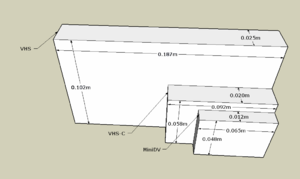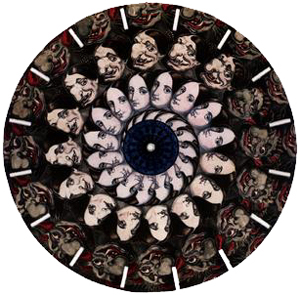Today, I was amazed by the evolution of technology. My boss assigned me a job to find a “VHS-C adapter.” What’s that, I asked. Then we turned over the whole office to find the little stuff. Let’s see what we got. A VHS-C Camera, lots VHS-C tapes and a VHS-C adapter. It‘s totally a camera between a traditional VHS Bata Cam and a digital camera. Seeing this, I nearly could imagine the thinking process in people’s minds. Wow~~ My English is limited to show my surprise, but I really appreciate to the special experience. I found some interesting information from Wikipedia about VHS-C.
VHS-C is the compact VHS format introduced in 1982 and used primarily for consumer-grade compact camcorders. The format is based on the same videotape as is used in VHS, and can be played back in a standard VHS VCR with an adapter. Though quite inexpensive, the format is largely obsolete even as a consumer standard and has been replaced by digital video formats.
 A size comparison between the original VHS format, VHS-C, and the more recent MiniDV.
A size comparison between the original VHS format, VHS-C, and the more recent MiniDV.
The magnetic tape on VHS-C cassettes is wound on one main spool and used a sort of a gear wheel which moves the tape forward. It can also be moved by hand and so is the spool. This development hampered the sales of the Betamax system somewhat, because the Betamax cassette geometry prevented a similar development.

Bottom and top view of VHS-C, compact video cassette
 Example of a VHS-C adapter
Example of a VHS-C adapter
VHS-C was one of the pioneering formats of the compact camcorder market, and was released to compete with Video8. VHS-C was larger than Video8, but was compatible with VHS tapedecks, making the choice between the two non-obvious, and splitting the market; VHS-C also eventually crowded full-sized VHS camcorders out of the market. A higher quality version of VHS-C was released, based on S-VHS, known as S-VHS-C, that competed against HI8, the higher quality version of Video8. The arrival on the market of inexpensive S-VHS-C camcorders led to the inclusion on many modern VCRs of a feature known as SQPB, or SuperVHS Quasi-PlayBack, but did not make a significant impact on the market as the arrival of MiniDV as a consumer standard made low-cost, digital, broadcast quality video rendered analog camcorders largely obsolete.
Although Video8 acquired a digital variant, Digital8, it is extremely unlikely that D-VHS will be adapted to a compact format, as the consumer camcorder industry (particularly VHS's inventor and main proponent, JVC) has largely standardized on MiniDV and small-format recordable DVD. Nevertheless, a few VHS-C and S-VHS-C camcorders are still available from JVC at extremely low price points (~US$200), and the media is relatively inexpensive compared with MiniDV tape.






